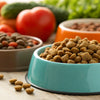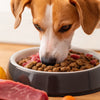Is Cat Kibble Safe for Dogs? Understanding the Risks and Nutritional Needs
- Houndsy
Table of Contents
- Introduction
- The Nutritional Differences Between Cat and Dog Food
- Potential Health Risks of Dogs Eating Cat Kibble
- What to Do If Your Dog Eats Cat Food
- Tips to Prevent Your Dog from Eating Cat Food
- Conclusion
Introduction
Picture this: your dog giving you those big, pleading eyes while sneaking a few munches from your cat's bowl. It's a scene many pet owners can relate to. In fact, studies reveal that nearly 60% of pet owners with both cats and dogs report their dogs trying to eat cat food at least occasionally. But is this harmless behavior, or does it pose a risk to our canine companions?
Understanding the nutritional differences between cat and dog food is crucial for maintaining the health and well-being of our pets. While a small amount of cat kibble may not cause immediate harm, the long-term effects of feeding cat food to dogs can be concerning. By the end of this post, we will delve into the implications of dogs eating cat kibble, explore the nutritional differences between the two, and provide insights on how to keep our furry friends safe.
We will cover various aspects, including:
- The nutritional differences between cat and dog food.
- Potential health risks associated with feeding cat kibble to dogs.
- What to do if your dog eats cat food.
- Tips to prevent your dog from eating your cat's food.
So, let’s embark on this informative journey together and make sure we’re giving our pets the best care possible.
The Nutritional Differences Between Cat and Dog Food
Before we dive into whether cat kibble is safe for dogs, it’s essential to understand the fundamental differences in their dietary needs.
1. Protein and Fat Content
Cats are obligate carnivores, meaning their diet requires high levels of animal-based protein. Cat food typically contains about 30-40% protein and 15-20% fat. This high protein content is essential for their energy, muscle maintenance, and overall health.
On the other hand, dogs are omnivores. They thrive on a more varied diet that includes proteins, carbohydrates, and fats. A typical dog food contains around 18-30% protein and 5-15% fat, depending on the specific dietary needs of the dog.
2. Essential Nutrients
Cats have specific dietary requirements that dogs do not share. For example, cats need taurine, an amino acid crucial for their heart and eye health. Dog food does not contain taurine because dogs can synthesize it from other amino acids. Additionally, cats require higher levels of arachidonic acid and vitamin A, which are not present in adequate amounts in dog food.
3. Caloric Density
Due to their higher protein and fat content, cat food is generally more calorically dense than dog food. This means that if a dog consumes cat food regularly, it may lead to weight gain and obesity over time.
Summary
In summary, while dogs can eat cat food occasionally without immediate harm, the nutritional imbalance from regularly consuming cat kibble can lead to health issues.
Potential Health Risks of Dogs Eating Cat Kibble
So, is cat kibble safe for dogs? The short answer is yes—dogs can eat cat kibble without it being toxic. However, there are several health risks that pet owners should be aware of.
1. Gastrointestinal Upset
One of the most common issues that may arise when dogs consume cat food is gastrointestinal upset. This can manifest as vomiting, diarrhea, or abdominal discomfort. The high fat and protein content in cat food can be difficult for some dogs to digest, especially if they have sensitive stomachs.
2. Weight Gain and Obesity
Due to the higher caloric density of cat food, dogs that regularly consume it may gain weight. Obesity can lead to a host of other health problems, including joint issues, heart disease, and diabetes. It’s crucial to monitor your dog’s weight and ensure they are fed a balanced diet appropriate for their needs.
3. Pancreatitis
Pancreatitis, an inflammation of the pancreas, can occur if a dog consumes too much high-fat food, such as cat kibble. Symptoms may include lethargy, vomiting, diarrhea, and abdominal pain. This condition can be serious and may require veterinary intervention.
4. Nutritional Deficiencies
While dogs can survive on cat food for a short time, long-term consumption can lead to nutritional deficiencies. Dogs require certain nutrients that are not present in sufficient quantities in cat food. Over time, this could cause health issues related to those deficiencies.
Summary
In conclusion, while the occasional nibble of cat kibble may not harm your dog, regular consumption can lead to serious health issues.
What to Do If Your Dog Eats Cat Food
If you catch your dog snacking on cat kibble, here’s what you should do:
1. Assess the Situation
If your dog has eaten a small amount of cat food, monitor them for any signs of distress, such as vomiting or diarrhea. If they seem fine, they will likely be okay.
2. Consult Your Veterinarian
If your dog has consumed a large amount of cat food, especially if they are predisposed to weight gain or have a history of pancreatitis, it's best to consult your veterinarian. They can provide guidance on whether your dog needs to be monitored or treated.
3. Skip a Meal
If your dog has overeaten cat food, consider skipping their next meal to allow their digestive system a chance to reset.
4. Monitor for Symptoms
Keep an eye on your dog for any symptoms of gastrointestinal upset or lethargy. If you notice anything concerning, don’t hesitate to reach out to your vet.
Summary
If your dog consumes cat food, don’t panic. A small amount is usually not harmful, but it’s always best to keep an eye on them and consult a veterinarian if necessary.
Tips to Prevent Your Dog from Eating Cat Food
To avoid the temptation of cat kibble, consider these strategies:
1. Separate Feeding Areas
Create distinct feeding areas for your cat and dog. Feeding them in separate rooms can significantly reduce the chances of your dog sneaking cat food.
2. Elevate Cat Food Bowls
Place cat food bowls on elevated surfaces that dogs cannot reach. This could be a countertop or a cat tree, allowing your cat to eat without interference.
3. Use Creep Feeders
Invest in a creep feeder designed for cats. These feeders allow cats to access food while preventing dogs from getting in.
4. Monitor Feeding Times
If your cat eats at specific times, ensure your dog is not around during those meals. This can help establish a routine that prevents snacking.
Summary
By implementing these strategies, you can help maintain a harmonious feeding environment for both your cat and dog, ensuring each pet gets the nutrition they need.
Conclusion
In conclusion, while the question of whether cat kibble is safe for dogs may seem straightforward, it unravels a complex web of nutritional needs and health risks. Dogs can occasionally munch on cat food without immediate harm; however, consistent feeding of cat kibble can lead to significant health issues.
We encourage pet owners to pay close attention to their dog’s diet and ensure they are receiving nutritionally balanced dog food. If you are looking for a convenient and aesthetically pleasing way to manage your dog's feeding routine, consider exploring the Houndsy Kibble Dispenser. Our innovative design combined with high-quality materials ensures your dog receives the right portions without the mess.
Remember, keeping your pets' diets separate is key to their health and happiness. Feel free to share your experiences and questions in the comments below!
FAQ
Q: Can my dog eat cat food occasionally?
A: Yes, a small amount of cat food is generally safe for dogs, but it should not be a regular part of their diet.
Q: What should I do if my dog eats a large amount of cat food?
A: Monitor your dog for any signs of distress and consult your veterinarian if necessary.
Q: Why is cat food bad for dogs in the long run?
A: Cat food is higher in protein and fat than what dogs need, which can lead to weight gain, pancreatitis, and nutritional deficiencies.
Q: How can I keep my dog away from my cat's food?
A: Feeding them in separate areas, using elevated surfaces or creep feeders can help prevent your dog from accessing cat food.
Q: Is there a specific type of dog food I should choose?
A: Always choose a dog food that meets your dog's specific nutritional needs based on their age, size, and health conditions.












